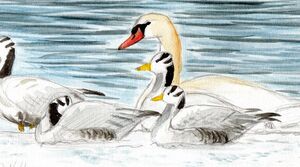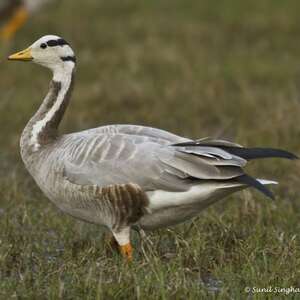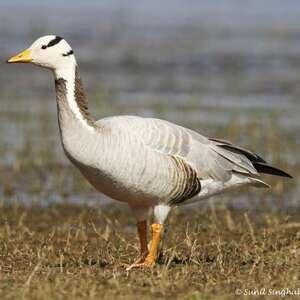Bar-headed Goose
Anser indicus - Oie à tête barrée
Identification
The Bar-headed Goose is very distinctive. Generally gray and white in appearance, it cannot be mistaken for any other goose either in terms of its physical characteristics, such as the shape of its skull, or its plumage. There is no sexual dimorphism, although in a pair one can distinguish the male by its slightly larger size than the female. The adult has the same plumage all year round. The head and sides of the neck are white with two horizontal black bars, which gave it its common name. The first bar is quite wide and short. It covers the back of the skull and connects the two eyes. The second one is longer and thinner. It is located at the bottom of the neck. The iris is brown. The yellow base beak becomes orange with a black nail. In profile, a white line runs down the dark brown to black neck. The chest, of the same color as the neck, becomes light gray towards the bottom. The abdomen and flanks are also light gray. These turn darker towards the back with the fringes of white feathers forming visible vertical stripes while standing. The lower abdomen and under-tail feathers are white. The back is dark gray, the scapulars are light gray with clear white stripes again formed by the fringes of the feathers. The primary and secondary remiges are light gray, the tertiary remiges are darker in the center. On the top of the light gray wings, the fringes of the large and medium coverts form thin pale lines, the inner primary and secondary remiges are black, and the external primary remiges are gray tipped with black. The underside of the wings is light gray on the coverts, the large coverts are gray with light tips, and the remiges are dark gray. The legs are yellow-orange. The complete moult takes place in June/July, generally 24 to 28 days after the hatching of the chicks.
The juvenile is similar to the adult but usually more dull. The blackish band descending on the nape is less clear and extends up to the crown, the two horizontal bands are absent. The feathers of juveniles being more rounded, no pale streak is visible on the body. Legs and beak are duller.
Hybridization cases exist in the Bar-headed Goose. In the wild, hybridization with the Graylag Goose is occasional. Some cases with the Brent Goose and possibly with the Eurasian Wigeon. In Europe, where the Bar-headed Goose has been introduced, hybrids are multiplied with the Canada Goose, the Barnacle Goose, the Swan Goose, the Dwarf Goose and the Laughing Goose. In captivity, it can hybridize with any kind of goose.
Subspecific information monotypic species
Foreign names
- Oie à tête barrée,
- Ánsar indio,
- ganso-de-cabeça-listada,
- Streifengans,
- indiai lúd,
- Indische Gans,
- Oca indiana,
- stripgås,
- Stripegås,
- hus vrchovská,
- husa tibetská,
- Indisk Gås,
- tiibetinhanhi,
- oca de l'Índia,
- Taumgæs,
- gęś tybetańska,
- kalnu zoss,
- tibetanska gos,
- Горный гусь,
- インドガン,
- 斑头雁,
- ห่านหัวลาย,
- 斑頭雁,
Voice song and call
The Bar-headed Goose, like many geese, can be quite noisy. It makes hin or han noises. In flight it makes light, slightly nasal honks. In a group, when perched, it makes whistles and trills. There are two alarm calls, one to warn of a predator bird's arrival and the other to announce a ground predator.
Habitat
The Bar-headed Goose can live and feed both on land and in water. On land, it looks for pastures and agricultural areas. Temporary or permanent wetlands of high altitudes are sought after during the breeding period. They generally prefer mountain lakes or flooded areas in steppic environments.
Behaviour character trait
The Bar-headed Goose is typically a migratory bird. It lives in couples, small family groups, or large colonies made of these groups. At night, groups will form together to make big sleeping roosts. As an herbivore, it searches mainly in pastures for food. It can nest singly or in colonies, which can include up to one thousand couples. The couple is usually monogamous and together for life, but some groupings consist of a male and multiple females.
Flight
Dietfeeding habits
Reproduction nesting
Every year after migration, the Bar-headed Goose returns to the same nesting site. It chooses wetlands to build its nest, usually high up among tall grasses near rivers and lakes.
The female lays between three and six eggs, though this can vary up to eight. Only the female incubates the eggs for 27 to 30 days. The chicks leave the nest on the second day and are able to feed themselves by day three or four. Young geese moult for the first time in October on the migration or wintering sites. This continues during the first winter when family groups stay together. Young geese are sexually mature by their second or third year.Geographic range
The Bar-headed Goose is a nesting species of Central Asia, mainly in China and Mongolia. It migrates in winter to South Asia. The species was introduced to Sweden in the 1930s without successful reproduction. In the 1950s and 1960s, it regularly nested in Norway. There are now a few breeding individuals in France and the UK. A slightly larger population is resident in Germany, Belgium and the Netherlands, never exceeding a hundred individuals per country. Easy to domesticate, escapes also reproduce in North America.
Threats - protection
IUCN conservation status
concern
in the Wild
threatened
evaluated
At a global scale, the Bar-headed Goose is not considered threatened, although its population trend appears to be decreasing due to hunting along migration routes. The taking of eggs from the nest and accidents related to human activities are causes of this reduction in numbers.
Sources of information
- IOC World Bird List (v15.1), Gill, F and D Donsker (Eds). 2025-12-07.
- Canards, cygnes et oies d'Europe, d'Asie et d'Amérique du Nord, Reeber Sébastien
- ARKive, Christopher Parsons
Other sources of interest
 Specification sheet created on
24/07/2023 by Nathalie Santa Maria
Specification sheet created on
24/07/2023 by Nathalie Santa MariaTranslation by AI Oiseaux.net
© 1996-2026 Oiseaux.net
- Accipitriformes
- Aegotheliformes
- Anseriformes
- Apodiformes
- Apterygiformes
- Bucerotiformes
- Caprimulgiformes
- Cariamiformes
- Casuariiformes
- Charadriiformes
- Ciconiiformes
- Coliiformes
- Columbiformes
- Coraciiformes
- Cuculiformes
- Eurypygiformes
- Falconiformes
- Galliformes
- Gaviiformes
- Gruiformes
- Leptosomiformes
- Mesitornithiformes
- Musophagiformes
- Nyctibiiformes
- Opisthocomiformes
- Otidiformes
- Passeriformes
- Pelecaniformes
- Phaethontiformes
- Phoenicopteriformes
- Piciformes
- Podargiformes
- Podicipediformes
- Procellariiformes
- Psittaciformes
- Pterocliformes
- Rheiformes
- Sphenisciformes
- Steatornithiformes
- Strigiformes
- Struthioniformes
- Suliformes
- Tinamiformes
- Trogoniformes






























